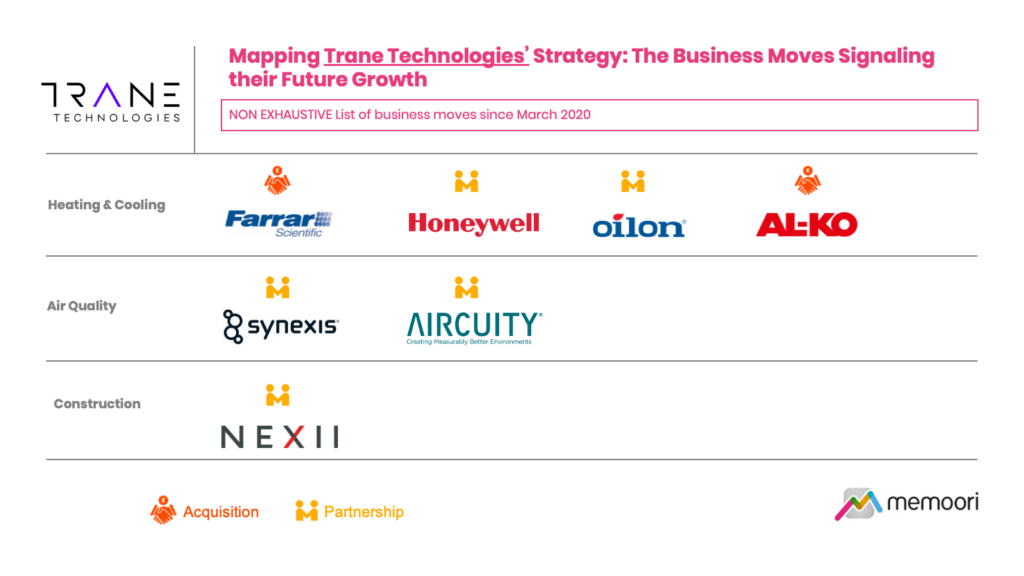In this Research Note, we take an in-depth look at the business strategy of Trane Technologies based on their acquisitions and partnerships since 2020. Trane Technologies was formed in 2020 following a spin-off from Ingersoll Rand’s Climate Division. As a vertically integrated enterprise, Trane offers commercial and residential HVAC equipment and aftermarket services as well as transport refrigeration solutions under the ThermoKing brand.
Since becoming a public company, Trane Technologies has repositioned itself as a pure-play “climate innovator”, with an increased focus on energy efficiency, sustainability and decarbonization of buildings, homes and transportation, fuelling their growth.
The enterprise reported strong financial performance in 2021 with $14.1 billion revenues, up 13% from the prior year. The company is considered to be a very competitive second tier supplier in the world building controls market, behind Siemens, Honeywell, Johnson Controls and Schneider Electric.
Here we map Trane’s acquisition and partnership strategy over the past two years in order to identify patterns that are shaping the future of the company and reflecting the direction of the market.

Heating & Cooling
Trane has made two acquisitions since its March 2020 spin-off. The first was ultra-low temperature control firm Farrar Scientific in 2021. The firm’s proprietary technology helps Trane fill a growing need for flexible, modular, and efficient ultra-low temperature process and storage, including cooling and heating.
The second, in September 2022, was AL-KO Air Technology, an HVAC production division of AL-KO SE, based in Germany. The acquired firm designs, manufactures, sells and services a ran of sustainable air handling units and extraction systems, which will complement Trane Commercial’s HVAC product and services portfolio. The transaction is expected to close by the end of the year.
Heating and cooling is a central focus for Trane and a key growth area for a buildings industry facing increasing demand for sustainability and cost savings solutions. According to our latest research, HVAC and Building Energy management-related devices grow at just under 12% per year from a 2022 level of 280 million devices to 485 million by 2027.
Trane also embarked on two partnerships in the heating and cooling space, the first with Honeywell to test a next-gen refrigerant, Solstice N41 is the industry’s first non-flammable alternative to the existing R-410A preference. The other heating and cooling partnership was a collaboration with Finnish firm Oilon, the pair co-designed and manufactured the Exergy Series of heat pumps.
Heat pumps are approaching cost-parity with fossil-fuel sources of heat in multiple markets. The relatively low adoption rates we have seen with heat pumps thus far are mainly down to installation cost and disruption, as there are no “one-size-fits-all” or “off-the-shelf” solutions. However, in recent years the demand for heat pumps is starting to pick up due to the rising cost of electricity and increasingly stricter environmental regulations around the world.
Air Quality
IoT-enabled indoor air quality monitoring & control solutions were largely niche and at a very nascent stage prior to the advent of the COVID-19 pandemic, but the market’s growth has been supercharged by increasing levels of awareness of the relationship between health outcomes, as well as the comfort and satisfaction of building users.
Demand for comprehensive end-to-end indoor air quality solutions has understandably grown during COVID and contributed to Trane’s Q4 high single-digit organic revenue growth in commercial HVAC Americas. Trane has partnered with two air quality specialists, Synexis for microbial reduction using dry hydrogen peroxide and with monitoring technology firm Aircuity, for enhancing air quality through monitoring and control.
Improving air ventilation and increasing the mix of outside air has been a key recommendation for building operators to mitigate the spread of COVID-19. This has knock-on cost, emissions, and energy implications for buildings, however, increasing the demand and value potential of more sophisticated HVAC monitoring and control systems to better manage the balancing of these competing priorities.
Construction
While high levels of vacancy during the pandemic created strong drivers for air quality improvement and energy/cost saving retrofit solutions, overall levels of demand for the construction of new commercial buildings remain at historically low levels. One area that still attracts investment is green buildings. In the 2021 RICS global survey, three-fifths of respondents reported a rise in demand for green buildings and nearly half saw evidence of rent and price premiums for them.
In 2021, Trane also forged a significant partnership in the construction industry with Nexii. The collaboration combines Nexii’s expertise in efficient building construction with Trane’s digitally enabled EcoWise climate comfort systems to reduce building energy usage and carbon emissions. Nexii’s has pioneered a proprietary material called “Nexiite,” that minimizes construction waste and energy use, while reducing build times and costs versus conventional building products.



